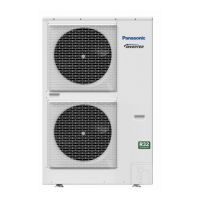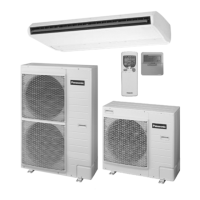1-12-1-1-12
1
CAUTION
If the exterior of the outdoor unit valves has been finished with
a square duct covering, make sure you allow sufficient space to
access the valves and to allow the panels to be attached and
removed.
After a tube has been insulated, never try to bend it into a
narrow curve because it can cause the tube to break or crack.
Never grasp the drain or refrigerant connecting outlets when
moving the unit.
Precautions for handling the valve cap
Ensure not to scratch the inner surface of the valve or the end of the valve shaft.
• Once adjustments to the valve are completed, ensure to tighten the valve cap according to the prescribed torque.
Precautions for handling the service ports
Use a push-rod with a charge hose.
• Once adjustments to the valve are completed, ensure to tighten the valve cap according to the prescribed torque.
Precautions for connecting the tubes
For proper connection, align the union and flare straight with each other.
Ensure that the tubes do not come into contact with the compressor’s bolts or exterior panel.
There is a risk of condensation from the 3-way valve coming out between the insulation material and the indoor unit’s
tubing when you install the outdoor unit above then the indoor unit. Ensure to caulk the connection parts.
Precautions for insulation installation
Maximum temperature limit of gas or liquid tubing exceeds 120 °C
In high humidity environment, reinforce the insulation material for the refrigerant tubing. Failure to do so may
result in condensation on the surface of the insulation material.
Use materials with good heat-resistant properties as the heat insulator for the tubes. Ensure to insulate both
the gas and liquid tubes.
If the tubes are not adequately insulated, condensation and water leakages may occur.
Ensure that the current insulation covers the tubes up to the unit’s connecting part.
If the tubing is exposed, it may cause condensation or burn (when touch the tube).
Precautions for flare nut installation
Use of the Flaring Method
Many of conventional split system air conditioners employ the flaring method to connect
refrigerant tubes that run between indoor and outdoor units. In this method, the copper
tubes are flared at each end and connected with flare nuts.
Flaring Procedure with a Flare Tool
(1) Cut the copper tube to the required length with a tube cutter. It is recommended to
cut approx. 30 – 50 cm longer than the tubing length you estimate.
(2) Remove burrs at each end of the copper tubing with a tube reamer or a similar tool.
This process is important and should be done carefully to make a good flare. Be sure
to keep any contaminants (moisture, dirt, metal filings, etc.) from entering the tubing.
When reaming, hold the tube end downward and be sure that no copper scraps fall
into the tube.
(3) Remove the flare nut from the unit and be sure to mount it on the copper tube.
(4) Make a flare at the end of the copper tube with a flare tool.
Dimensions when adding flare nuts and the tightening torque
For the flare nuts at tubing connections, be sure to use the flare nuts that were supplied with the unit. The refrigerant tubing that is used must be of the
correct wall thickness as shown in the table below.
Tubing size Tightening torque (approx.) Flare section dimensions A Tube thickness Flare configuration
ø 6.35 14.0 N•m~18.0 N•m {140 k
g
f•cm~180 k
g
f•cm} 8.7 ~ 9.1 mm 0.8 mm
45° ±1°
ø 9.52 34.0 N•m~42.0 N•m {340 k
g
f•cm~420 k
g
f•cm} 12.8 ~ 13.2 mm 0.8 mm
ø 12.7 49.0 N•m~55.0 N•m {490 k
g
f•cm~550 k
g
f•cm} 16.2 ~ 16.6 mm 0.8 mm
ø 15.88 68.0 N•m~82.0 N•m {680 k
g
f•cm~820 k
g
f•cm} 19.3 ~ 19.7 mm 1.0 mm
ø 19.05 100 N•m~120 N•m {1020 k
g
f•cm~1220 k
g
f•cm} 23.6 ~ 24.0 mm 1.2 mm
After tubing connection has completed, ensure there is no gas leakage.
Because the pressure is approximately 1.6 times higher than refrigerant R22 pressure, the use of flare nuts (type 1) or
thin-walled tubes may result in tube rupture, injury, or asphyxiation caused by refrigerant leakage.
When tightening the flare nut, coat the flares (inner surface only) with refrigerant oil on the flares. Firstly, screw in 3-4
turns by hand.
* Ensure not to get oil on the screw part.
Refrigerant oil used is ether-based.
Once the tubing connections are completed, perform leakage inspection using nitrogen gas.
When flared joints are reused, the flare part shall be re-fabricated.
Selecting the location for installation service
AfterBefore
Deburring
Copper
tubing
Reamer
Flare nut
Copper tubing
Flare tool
Inter-unit
control wiring
Gas tube
Liquid tube
Armoring tape
Insulation
Two tubes arranged together
Application for ether-based oil
Tightening torque (approx.)
Valve cap
(Valve size)
ø9.52
(Liquid tube)
34 N•m~42 N•m
{340 k
g
f•cm~420 k
g
f•cm}
ø12.70
(Liquid tube)
49 N•m~55 N•m
{490 k
g
f•cm~550 k
g
f•cm}
ø19.05
(Gas tube)
100
N•m~
120 N
•
m
{1000 k
g
f
•
cm
~
1200 k
g
f
•
cm}
Service port
10.7N•m~14.7N•m
{107 k
g
f•cm~147 k
g
f•cm}
Tubing
Insulation
material
Caulking treatment, etc.
SM830276-00_欧州向け R32シングル TD&SM.indb 12 2019/02/27 11:54:28

